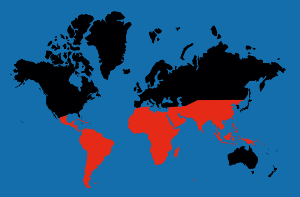Accra, March 19, GNA - The Monetary Policy Committee (MPC) on Monday gave a positive assessment of the economy but warned that the continued load shedding and unpredictable energy supply could impact negatively on the economy.
"(However,) continued load shedding and unpredictable energy supply is constraining activity in, especially the energy sensitive sectors with the risk of potential output losses and cost price pressures in the immediate horizon," Dr Paul Acquah, Governor of the Bank of Ghana, told a Press Conference in Accra.
Dr Acquah, who is also the Chairman of the MPC, said the economic fundamentals remained strong with the last quarter of 2006 witnessing increased economic activity, mostly driven by fiscal expansion. He said implementation of a firm budgetary expenditure policy well aligned with budgetary resources in the current budget should support steady fiscal consolidation, put downward pressure on prices and sustain the progress toward achieving the single-digit inflation target with accelerated growth.
On the whole, Dr Acquah said, the economy was positioned firmly on the path of declining inflation, and towards the goal of single-digit. It is in this direction that the Monetary Policy Committee had decided to maintain the Prime Rate at 12.5 per cent.
Besides, business and consumer confidence indicators are at high levels and inflation expectations relatively subdued, with stability in the foreign exchange markets.
The Bank's Composite Index of Economic Activity indicates a pickup of growth in the fourth quarter to 11.7 per cent in real terms, with year-on-year real growth of 17.5 per cent above the trend growth of 10.2 per cent.
"All the sub-components of the index recorded significant increases except for the notable declines of cement sales and industrial consumption of electricity, which have strong links with the on-going electricity load management," Dr Acquah said.
According to Dr Acquah the banking industry was building up strong balance sheets and an increasing or diversified asset and private sector credit portfolio of improving quality that should support continued economic expansion.
Bank credit to private and public institutions increased by =A27,156.4 billion (37.6 per cent) to A226,177.4 billion in the 12-months to January 2007.
The manufacturing sector absorbed 23.6 per cent, followed by services (21.0), commerce (18.4 per cent), construction (13.6 per cent) and mining and quarrying (5.7 per cent).
In real terms, credit to the private sector increased by 32.6 per cent, significantly higher than 14.9 per cent recorded for the same period in 2006, and the highest in 35 months.
Dr Acquah said the financial sector was also seeing increased growth as banks took advantage of opportunities to diversify their portfolios and grow their assets.
He said based on the latest data available, total assets of the banking industry grew by 41.1 per cent to A251,837.2 billion (45.1 per cent of GDP) at the end of 2006, compared with 17.5 per cent in 2005 (37.9 per cent of GDP).
"This development continued into January 2007 with annual growth of 38.1 per cent. This is driven mainly by increases in gross loans and advances."
Dr Acquah said the growth in the financial sector was also taking place against the background of improved financial sector soundness indicators. The banking system is well capitalised, profitable, efficient and fairly liquid.
Banks' solvency remained strong as the industry recorded Capital Adequacy Ratio (CAR) of 17.0 per cent as of January 2007 compared with 16.1 per cent same period in January 2006 and against a required Capital Adequacy Requirement of 10 per cent.
He said the ratio of Non-Performing Loans (NPLs) in total loan portfolio continued to decline. It fell from 11 per cent in October 2006 to 7.9 per cent in December 2006 and further to 7.5 per cent at the end of January 2007.
Similarly, NPLs' net of provision fell from 5.9 per cent in October 2006 to 2.0 per cent in December 2006 and to a low of 1.3 per cent in January 2007.
All measures of operational efficiency and profitability of the banking industry (deposits to total assets, cost to income, deposits per employee, assets per employee, net income, operating profits) with the exception of cost to income and cost to total assets, improved during the period.
Dr Acquah said the external payment outlook remained positive with commodity prices for cocoa and gold holding firm.
The overall balance of payments position improved from a surplus of US$84.34 million in 2005 to US$415.12 million in 2006.
Total exports recorded an increase of 33.0 per cent during 2006 over the 2005 level to US$3,726.67 million.
Growth in exports during the third quarter of 2006 was sustained into the fourth quarter with a marginal (1.1 per cent) increase to US$932.10 million. The fourth quarter export growth was driven by growth in non-traditional exports (34.5 per cent) and gold exports (1.2 per cent).
Dr Acquah said total imports in 2006 rose by 22.0 per cent to US$6,753.68 million. Capital and intermediate goods accounted for 73 per cent of total imports.
The relatively high import growth in the third quarter of 2006 slowed down by 2.2 per cent in the fourth quarter, driven mainly by a relatively smaller oil imports in the fourth quarter of 2006. Total oil imports for 2006 increased by 45.7 per cent to US$1,646.1 million, significantly above the US$1,129.4 million recorded in 2005, reflecting an increase in realised unit price and 2.3 per cent in volume over 2005.
"The current account recorded a deficit of US$810.2 million compared to US$773.4 million in 2005. However, the overall balance recorded a surplus on the strength of debt cancellation, private capital flows, and unrequited transfers raising gross international reserves to US$2.05 billion at the end of February 2007.
Dr Acquah said private inward transfers, including those received by NGOs, embassies, service providers, individuals, through the banks and finance companies for January-December 2006 amounted to US$5.78 billion, which represented 21.5 per cent increase over those for 2005, which were in turn 58.3 per cent increase over the transfers through banks and finance companies in 2004.
He said the foreign exchange market remained buoyant in 2006 with purchases and sales of foreign exchange by the banks and forex bureaux increasing by 16.6 per cent over the 2005 level to US$6.8 billion. Cumulative purchases and sales for the first two months amounted to US$1,140.87 million compared with US$1,086.43 million recorded for the same period in 2006.
On Government expenditure, Dr Acquah said total expenditure for 2006 (including the supplementary budget) amounted to A239,828.6 billion, exceeding the budgetary ceiling by 2.4 per cent.
He said provisional data on the execution of 2006 Budget indicated that total revenue and grants (including the supplementary budget) amounted to A231,917.7 billion against an end year target of =A234,135.4 billion (a shortfall of 6.9 per cent).
The overall budgetary deficit - including the supplementary budget- for 2006 resulted in a net domestic financing of A24,765.2 billion (4.2 per cent of GDP).
Dr Acquah explained that the financing of this deficit caused a bounce in the public debt/GDP ratio from 10.8 per cent to 13.5 per cent. This was accompanied by a significant lengthening of the maturity structure of the stock of public domestic debt.
He cited revenue shortfalls and unrealised resources under the Supplementary Budget, which contributed about 3.7 per cent of GDP to the total fiscal deficit for the fiscal deficit.
In addition, public sector wage settlements, which were about 13 per cent in excess of programme, and unexpected transfers to manage the energy crisis overstretched the expenditure under the Budget.
General News of Monday, 19 March 2007
Source: GNA












